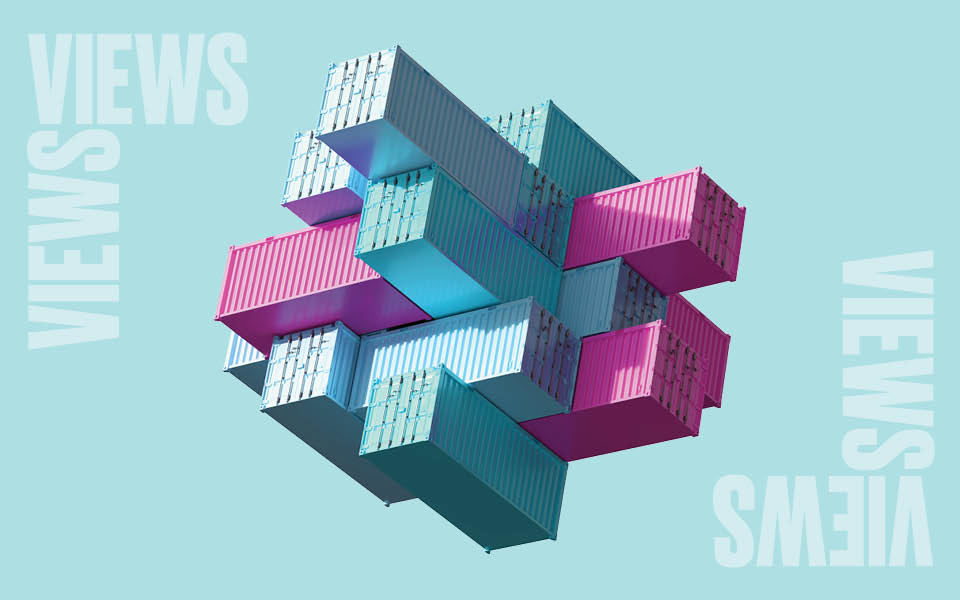Global trade is undergoing a transformation, shaped by shifting trade corridors and the accelerating impact of digitalization. Alongside these structural changes, financial institutions are navigating uncertainty and adapting to new regulatory and operational demands. In this roundtable moderated by BNY, representatives from the Asian Development Bank, BAFT (Bankers Association for Finance and Trade), and the International Chamber of Commerce (ICC) discuss how the trade ecosystem is adapting to change — and the new opportunities that the current uncertainty presents.
Roundtable participants:
- Moderator: Joon Kim, Global Head of Trade Finance and Cash Management Platform, Treasury Services, BNY
- Steven Beck, Head of Trade and Supply Chain Finance, Asian Development Bank
- Vincent O’Brien, Director, International Chamber of Commerce UAE
- Tod Burwell, President & Chief Executive Officer, BAFT (Bankers Association for Finance and Trade)
- Bob Savage, Head of Markets Macro Strategy, BNY
Q: Tariffs, Covid-19 and a shifting macroeconomic environment have all contributed to profound changes in global trade. These forces are part of a broader reshaping that has been underway for some time, characterized by the reconfiguration of trade corridors and a rethinking of established models. Supply chains are diversifying, intraregional flows are expanding and geopolitical dynamics are creating both risks and opportunities. How do you see these changes playing out? And is their impact being felt evenly across jurisdictions, or are certain markets experiencing the effects more acutely?
Steven Beck: There is a clear push to diversify trade links, with Asia’s role in the global economy set to expand further. Interregional exchange, for example, has long been a defining feature, but with China on track to become the world’s largest consumer market by 2030, momentum in this direction will likely accelerate further. Another important shift we are seeing is to underlying settlement currencies. While the dollar remains dominant and likely will remain so for a long time, there is increased demand for alternatives, including the renminbi, particularly in South-South trade flows like Brazil-China. This reflects both geopolitical dynamics and the practical need for flexibility.
Bob Savage: USD payments and global trade growth are connected, but as we see in the data, the volume of global payments — outside of the dollar — is rising, with digital solutions using stablecoins and increasing interest in CNY. The view of global growth has stabilized and looks to be rebounding, with mixed views on the role of the United States demand into 2026. Overall, the trade finance world is reaching into areas of the world that traditionally are “underbanked,” where digital solutions are providing leverage to smaller enterprises, particularly in frontier markets. This makes the growth of the business broader, regardless of the debate about USD competition with other currencies, which will likely continue to be a story for decades.
Vincent O’Brien: That reconfiguration is also prompting businesses to explore opportunities they may not have considered before — and this is set to drive significant shifts in trade flows. For example, the UAE’s position as a gateway connecting east, west, north and south presents a major advantage. Demographics also point to long-term opportunity: populations are expanding and remain predominantly young. Looking ahead, Africa stands out as the continent of opportunity, with the UAE and other regional trade hubs playing a critical role as bridges linking Asia to Africa.
Tod Burwell: I share that sense of opportunity but remain cautiously optimistic. While some structural elements are in place, geopolitical and economic risks will need to be navigated carefully over the next 12–18 months. Over the longer term, growth is likely to be underpinned by technology, collaboration and innovation in trade finance. Realizing this potential will require financial institutions and corporates to work more closely together across the ecosystem.
Q: Banks and financial institutions (FIs) are fundamental to enabling trade, but they’re facing growing pressure to adapt, whether that means closer alignment with multilateral development banks (MDBs), more efficient use of standards and data, or accelerating digital adoption. What can banks and FIs do better to make sure that they remain relevant and effective partners in this changing finance ecosystem?
Tod Burwell: One area that you mentioned is accelerating digital adoption. That means establishing the right legal frameworks, investing in interoperable technology solutions and taking practical steps, such as supporting the wider recognition of electronic documents among corporates and the wider trade ecosystem. At the same time, emerging innovations like tokenization and digital assets may open new channels of liquidity, particularly for SMEs (small and midsize enterprises).
Steven Beck: For us, as an MDB, collaboration is equally critical. Trade plays a central role in lifting people out of poverty, and we support this through guarantees and loans — assuming risks commercial banks may not take and facilitating trade relationships that might otherwise not exist. Banks and financial institutions could do a better job of collaborating with MDBs to support new opportunities, particularly as trade patterns diversify. This will ultimately help make financing available to the many businesses that remain underserved.
Vincent O’Brien: In addition, the adoption and promotion of standardization is key. Operating in over 100 countries, we deliver rules and standards — such as UCP 600 for letters of credit — which have facilitated trade for more than a century by offering consistency and legal certainty. By standardizing practices, we make it possible for banks and financial institutions to operate efficiently across jurisdictions, supporting the smooth execution of global trade transactions and mitigating risk through widely recognized frameworks.
But banks must also address another important gap: broader participation in trade finance data sharing. The ICC Trade Register, for example, provides critical insights into defaults and risks, but its value is limited by the breadth of data it captures. With greater cooperation from banks, the register could become more comprehensive and representative — helping institutions make better-informed risk decisions and giving regulators a clearer, evidence-based view of the market.
Q: Digitalization is an important piece of this puzzle — and is often seen as a powerful tool for transforming trade finance. But progress has been uneven. New technologies promise a smoother flow of information, stronger fraud prevention and new sources of liquidity through tokenization. But markets are struggling with fragmented systems and outdated legal frameworks. How do you see digitalization reshaping trade finance in the coming years?
Tod Burwell: Many of the “building blocks for digital trade” are already in place. The technology exists, and there has been meaningful progress on developing the legal frameworks needed to support true digital trade — and this puts us in a strong position to move forward over the next few years. However, some critical pieces are still missing to create a stable structure. A key challenge, for example, is demonstrating the value proposition to corporate clients: where, in practical terms, will they see the benefits of their investment in digitalizing the financial side and not just the logistics? Until that question is answered convincingly, adoption is likely to remain uneven.
Steven Beck: Building on that, it’s not only about convincing corporate clients of the value of digitalization — it’s about digitalizing the import-export process, which today is laden with a mountain of paper. Converting that paper to data would be transformative. Trade digitalization involves moving data through the trade ecosystem, meaning between exporters, shippers, ports, customs, logistics providers, financiers and importers — without that end-to-end integration, the financing side of trade can never be truly digitalized. Our focus is on driving consensus on 35 main import-export standard electronic documents with all parties. And to ensure interoperability where multiple standards exist. Equally important is establishing legislation that recognizes electronic documents, a goal we are pursuing through the Digital Standards Initiative and dedicated working groups involving all major MDBs.
Vincent O’Brien: I agree with both Tod and Steven. It’s not enough to develop frameworks; companies and banks need certainty that a digital document will be recognized across borders, in courts and by regulators — and, crucially, makes things easier. Once again, standardization has a central role to play, supported by new technologies. For example, AI is already adding momentum, particularly in fraud prevention and compliance, by analyzing vast data sets in real time and helping institutions make faster, better decisions.
Q: Even with all the progress we’ve discussed, it’s clear there are still significant unrealized opportunities in trade finance — most notably supporting SMEs and bridging the well-known trade finance gap. Where do you see the biggest opportunities currently being missed, and what steps does the industry need to take to capture them?
Steven Beck: Many opportunities remain underdeveloped, particularly for SMEs in developing Asia. Despite strong demand, financing gaps persist because banks struggle to scale efficiently and often perceive these jurisdictions or clients as higher risk.
The potential for supply chain finance (SCF) to narrow financing gaps for SMEs has yet to be fully realized. While there’s more scaling to be done in the reverse payables space of SCF, financial institutions, including ADB and other MDBs, need to move deeper and more broadly into the supply chain. SCF is a great innovation structured to mitigate SME risk — there’s a lot more we can do with it to close the financing gaps that will underpin more growth, jobs and development.
Tod Burwell: I’d add that SMEs are still underserved because of structural and regulatory barriers that go beyond technology. Banks and institutions could unlock more potential by advancing standardization, improving data sharing and coordinating more effectively across jurisdictions. When combined with scalable technology solutions, these steps would significantly expand access to trade finance.
Vincent O’Brien: Fragmented systems across jurisdictions also create friction — making it harder for banks and corporates to operate efficiently. Greater interoperability and stronger coordination across the trade ecosystem would unlock significant potential, reduce delays and make financing flows faster and more predictable for SMEs. At the same time, traditional supply chain finance remains underutilized. Too often, it focuses on the post-shipment or post-acceptance phase of the supply chain. So, there’s so much opportunity for us to provide support earlier and go deeper into the supply chain, where SMEs are most in need.
The big trade opportunity for SMEs is unfolding right before our eyes, but in my opinion the banks are not seeing it. Despite the lackluster growth of trade in goods, cross-border services trade grew by close to 9% last year. This impressive growth is driven to a large degree by SMEs, as to enter the international services market relatively little capital investment is required. Emerging markets are comparatively contributing more to this growth in services trade, and this trend will not only continue, but also accelerate.
Joon Kim: What strikes me from our conversation is that while we often speak about themes like digitalization, standardization and SME access as distinct priorities, they are in fact part of the same puzzle. Each reinforces the other: standardization provides the foundation, digitalization and emerging technologies build on it and, together, these efforts enable us not only to navigate uncertainty but also to unlock new opportunities. The glue that holds it all together is collaboration. I believe the future of trade finance will be shaped less by the success of any single component and more by the collective ability of the ecosystem to bring these pieces together. That is why conversations like this are so valuable — thank you for your time.




